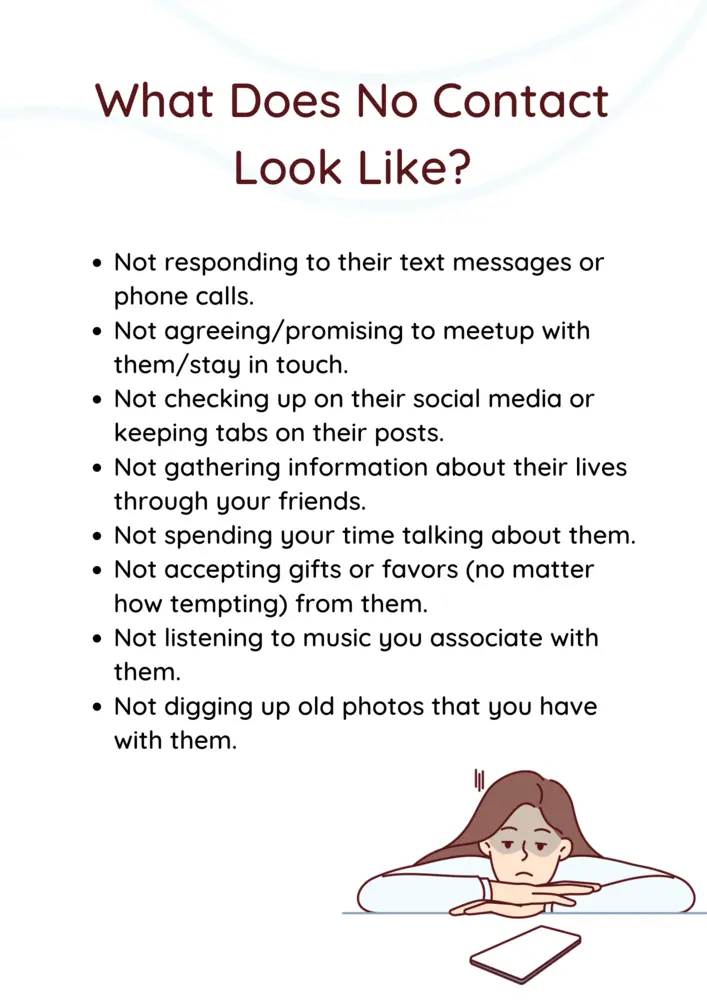Closure is a common challenge blocking the path to recovery for many people trying to heal from narcissistic abuse. Generally speaking, it is achieved through:
- Learning about narcissism and narcissistic abuse.
- Seeking help from a mental health professional.
- Using the No or Low Contact Method.
- Practicing self-care.
- Building a healthy support system.
- Focusing on self-reflection and personal growth.
- Practicing forgiveness.
In this article, I will guide you through each one of these steps towards closure that you can take.
1.) Learn about Narcissism and Narcissistic Abuse
To get closure from a narcissistic relationship, you could first learn more about narcissism and narcissistic abuse.
This is important because when you take the time to grasp a comprehensive understanding of this type of abuse, it’s easier to see that the narcissist’s behavior stems from their mental condition, not your shortcomings.

Being aware of this helps you detach the narcissist’s actions from your self-worth and slowly release their emotional hold over you.
Education is an essential part of closure, and it helps you to close the chapter on self-blame and open a new one of self-discovery and self-compassion.
2.) Seek Help from a Mental Health Professional
The second thing you could do to get closure from a narcissistic relationship is to seek help from a mental health professional.
Now, you shouldn’t go searching for just any professional. You should be looking for one who genuinely understands narcissism and narcissistic abuse.
Why?
Well, because they will have the tools and knowledge to help you navigate the complex feelings and experiences associated with narcissistic abuse.

They will help you unpack the emotional abuse you experienced so that you can see the relationship more clearly, they will help you rebuild your self-esteem, and they will help you regain trust in your judgment.
Seeking help from a mental health professional who understands narcissism and narcissistic abuse is a great step that you can take toward closure.
3.) Go No or Low Contact with the Narcissist
The third thing you could do to get closure from a narcissistic relationship is going no or low contact with the narcissist in your life.
Let’s start this section off by talking about no contact.
Going no contact with a narcissist means ending all physical and psychological forms of communication that you have with them.

It is like setting up a protective barrier between you and the narcissist. Each day without contact is a day spent healing, growing, and regaining control of your life.
It is a fantastic technique because when you cut off communication, you stop the flow of harmful influences and prevent the reopening of old wounds.
This boundary reinforces your independence and control over your own life.
As time passes, the narcissist’s influence fades, and you can focus on your healing, ultimately bringing you to a place of closure.
Again, this is an amazing technique, but unfortunately, it isn’t always feasible.
Suggested Reading: Why Is It So Hard to Go No Contact With a Narcissist?
If you’re in a position where going no contact isn’t possible, then going low contact is your next best option.
This means setting boundaries that minimize the number of interactions you have with the narcissist in your life.
Suggested Reading: How to Set Boundaries With a Narcissist
For example, imagine that you’ve recently separated from a romantic narcissistic partner, but going completely no-contact isn’t an option.
Some boundaries you could set to adhere to the low contact strategy could be limiting communications to only necessary topics and using written communication (e.g., email & texting) rather than in person or over the phone, as much as possible.
This would be great because by minimizing and controlling the nature of your interactions with the narcissist, you are setting boundaries to help you heal and move toward closure.
4.) Practice Self-Care
The fourth thing you could do to get closure from a narcissistic relationship is practice self-care.
Self-care is the practice of taking an active role in protecting one’s well-being and happiness, in particular during periods of stress.
Suggested Reading: 10 Ways to Love Yourself After Narcissistic Abuse
This is such an important part of healing from narcissistic abuse because practicing self-care regularly is a powerful affirmation of your self-worth.
Each act, whether it’s maintaining a healthy diet, regular exercise, adequate sleep, or engaging in activities you love, is a testament to your worthiness of care and respect.

When you take care of yourself, you’re effectively reminding yourself daily that you matter, your needs are important, and you deserve happiness.
This daily reaffirmation helps you shift your mindset from accepting harmful treatment to expecting respect and care.
This shift is the essence of closure.
5.) Build a Healthy Support System
The fifth thing you could do to get closure from a narcissistic relationship is build a healthy support system.
A support system refers to a network of trusted individuals who provide emotional, psychological, physical, and sometimes financial support.
In this context, building a support system means surrounding yourself with people who understand your experiences, empathize with your feelings, and validate your reality.
Suggested Reading: 10 Ways to Support Someone In a Narcissistic Relationship
This might include friends, family members, therapists, or support groups of people who’ve been through similar experiences.
This support network is a reminder that you’re not alone, that your feelings are understood and validated, and that can greatly contribute to closure.
6.) Focus on Self-Reflection and Personal Growth
The sixth thing you could do to get closure from a narcissistic relationship is to focus on self-reflection and personal growth.
Self-reflection means serious thought about one’s character and actions and personal growth refers broadly to a subset of personality development that relates to the process of becoming better in a personally meaningful way.

After leaving a narcissistic relationship, it is very common to need time and space to process the experience and what it means for you.
Reflecting on the relationship can be painful, but it is important because it allows you to identify aspects of your life that you want to change.
It’s an opportunity to understand your boundaries better and learn how to enforce them. The more you understand about your past, the more you can learn and grow.
Suggested Reading: 10 Ways to Grow as a Person After Narcissistic Abuse
By focusing on self-reflection and personal growth, you’re preparing yourself for healthier future relationships and closing the chapter on the painful memoirs of the past, which is an essential part of finding closure.
7.) Practice Forgiveness
The seventh thing you could do to get closure from a narcissistic relationship is to practice forgiveness.
Right now, you might be thinking, “What do you mean by forgiveness? I shouldn’t have to forgive them for what they did to me.”
If this is the case, I won’t hold it against you because I thought the same thing for a long time. But in the context of healing, forgiveness is a personal, internal process focused on releasing the emotional burdens that negatively affect your well-being.
It isn’t about absolving the narcissist of their harmful actions or forgetting the pain they’ve caused you. Instead, forgiveness is about releasing the anger and resentment you’re carrying, which serves only to keep you tied to the past.
By choosing to forgive, you’re not saying what they did was okay, but rather you’re deciding that it won’t hold power over you anymore.
This decision is pivotal in achieving closure, as it represents the ultimate act of releasing the past and freeing yourself from the associated hurt.
What Should You Take Away from This Article?
Everyone is going to have a different idea of what closure from a narcissistic relationship looks like. But the seven aspects of closure that I listed today will direct you down a path of healing, growth, and happiness.
About the Author

Hey, I’m Elijah.
I experienced narcissistic abuse for three years.
I create these articles to help you understand and validate your experiences.
Thank you for reading, and remember, healing is possible even when it feels impossible.
